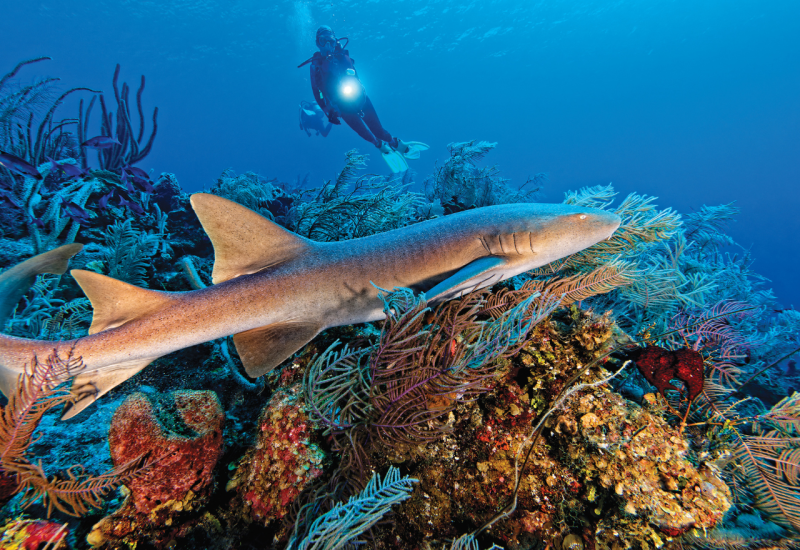The Practical Guide to Cave Diving

Pinpoint buoyancy control and modified fin kicks are two important safety skills for cave and cavern divers.
According to the old saying, "Curiosity killed the cat." The same holds true for open-water divers who swim into flooded caverns and caves beyond the limits of their gear and abilities.
In the words of the National Association of Cave Diving (NACD): "Cave diving is deceptively easy." Of course, NACD means it's a deceptively easy way for the untrained to die. The caverns and caves of central Florida alone have claimed well over 400 divers — yet thousands of tech divers safely visit these same passages every year. What's the difference between statistic and survivor? Proper training in cave diving techniques.
Silt Happens
The closed environment of flooded caves and caverns — the thing that makes them so interesting in the first place — also creates a world of unique hazards. Minimizing these hazards requires a different set of skills and techniques than those you learned in any open-water certification course.
Some hazards are obvious: low or zero light, the maze-like passageways that require penetration lines to follow, the inability to surface in case of emergencies. But one of the less obvious hazards of cave and cavern diving is silt. It's found in nearly every cave system. Whether composed of clay, decomposing vegetation or both, silt has the ability to eradicate visibility. One wrong fin kick or errant hand scull and the air-clear water becomes brown murk, and it can stay that way for days.
The solution to this hazard is spot-on buoyancy control and modified finning techniques that are at the heart of cavern and cave training.

Photography by Masa Ushioda/Seapics.com
-
1) Spring Basins: Though connected to subterranean caves and caverns, these open-water pools require no special training or equipment. Access to the surface is not restricted, so divers can ascend directly to the surface in case of emergency. However, untrained divers must exercise caution and avoid entering caverns and caves. Stay in ambient light (both behind and in front of you). Often, the spring's owner or dive operator prohibits open-water divers from carrying dive lights.
-
2) Caverns: A cavern is simply the entryway to a cave where natural light penetrates and the entrance is always visible. However, the restricted environment may prevent divers from ascending directly to the surface and can present additional hazards including silt and confusing passageways. Caverns can be safely explored after a short training program and with a minimum amount of additional equipment. Some training agencies place certain depth or linear penetration restrictions on cavern divers.
-
3) Cave: At heavily dived sites, the entrance to the full cave environment is usually blocked by a locked grate or marked with "grim reaper" warning signs that make no bones about the deadly consequences of venturing inside. Cave certification and full cave diving gear are necessary to explore these restricted areas.
Mastering Buoyancy Control
Expert buoyancy control is largely a matter of weighting. Most recreational divers come to cavern classes overweighted. As a matter of practice, there has never been a reason for them to fine-tune their buoyancy, and most are surprised to find one of their first tasks is removing excess weight.
Overweighted divers have a tendency to swim through the water in a very inefficient position. The ballast weight pulls the diver's lower body down while the buoyancy in the BC pulls the shoulders up, giving the diver the hydrodynamics of a Peterbilt truck. This position also forces water from every kick of the fins directly into the silt on the bottom of the cavern.
In addition to losing some weight, divers typically have to relocate the weight on their gear to achieve proper trim in the water. Ideally, the cavern diver will swim through the water with a slightly head-down attitude. This places the fins slightly above the midline of the body and directs the thrust of the fins up and away from the sediments on the bottom of the cavern.
There are a number of methods for accomplishing this trim modification, including holders that position weights on the tank directly behind the shoulders. This brings the buoyancy of the BC in line with the ballast weight, helping to achieve neutral buoyancy without rotating the diver into an upright position.
Cave and cavern divers also trade aluminum tanks, which become positively buoyant at the end of the dive, for steel tanks, which maintain slightly negative buoyancy even when empty. The steel cylinder also provides a better distribution of negative buoyancy because of the weight-to-size ratio.
Another difference between open-water diving and cavern diving is that weights are positioned so that they cannot be dumped. In open water, dumping your weights assists you in reaching the surface. Inside a cave, the same act results in pinning you helplessly to the ceiling.
The whole process can be summed up as the rule of minimums: Use the minimum amount of weight required to achieve neutral buoyancy with the minimum amount of air in your BC.
Kick the Habit

Modified fin kicks are another adaptation divers must make when entering a cave environment. Cave and cavern divers rarely use the full flutter kick because it produces too much turbulence directed toward the bottom. Cave and cavern certification courses typically cover two alternative kicks:
Frog Kick. The most common modified kick is the frog kick, which is accomplished by spreading the legs, rotating the fins so that the bottom of the fin blades come as close to facing each other as possible and then bringing the fins together, forcing water from between the two blades.
This kick isolates nearly all of the thrust and water turbulence to the area immediately behind the diver and requires a good deal less energy than a standard flutter kick.
In addition to increasing endurance and decreasing air consumption, the frog kick also provides another interesting benefit--you'll swim straighter. Most divers tend to drift slightly right or left as they flutter kick because one leg is slightly stronger than the other. Using the frog kick, the majority of all thrust comes from between the fins and directly behind the diver, which minimizes drift.
Modified Flutter Kick. This kick is accomplished by bending the knees slightly and shortening the stroke of the kick. When done properly, all fin movement takes place above the center of the body, minimizing water movement below the body.
After the cavern diver masters the new finning techniques, he'll learn how to utilize the fins to rotate his body with minimal disturbance of the water column. When mastered, this skill will allow the diver to utilize one fin to rotate his body on a point very close to the body's center.
The Payoff
When all the skills are combined, the well-trained cavern diver can swim, manage a light and a reel, keep track of his buddy without touching the cavern walls or disturbing its silt-laden bottom. Mastering these skills literally opens a new world to the recreational diver--a world of unique and beautiful geology unlike any other in diving.
Even if exploring caves and caverns isn't your idea of underwater fun, a cavern course conducted by a qualified instructor will equip you with useful skills for better open-water diving.
If you think back to your last few dive trips, you will probably remember seeing a cavern diver. He was the diver who stepped off the boat, descended slowly and efficiently to the bottom, never making contact, turned effortlessly into a proper swimming position and moved just as effortlessly through the entire dive. He never damaged the bottom with a touch or an erratic fin kick and his fins never disturbed a single grain of sand. These are the marks of the diver who has mastered buoyancy control, one of the essential skills in cavern exploration. If better buoyancy is your goal, a cavern course is a good place to learn it.
Spring, Cavern and Cave: What's the Difference?

The popularity of freshwater spring diving has led to some confusion among divers about cave and cavern environments and the limitations that apply.
The Evolution of a Cave Diver
The path from open-water diver to full cave certification involves a progressive series of certifications that teach divers specialized techniques and introduce new gear.
STEP 1: CAVERN CERTIFICATION
A two-day cavern training course is the first step in the evolution from open-water diver to cave diver. Cavern students typically use their open-water equipment with the addition of two dive lights (a primary and a backup), a safety reel and an extended hose on one of the second stages. The course includes four cavern dives and about four hours of academics focusing on very basic line handling, buoyancy control and alternate finning techniques.
STEP 2: INTRO TO CAVE
This course is a true technical diving program, and intro students can expect a good dose of reality with their training. The training process is based on accident analyses and much of the academic program is about the mistakes cave divers make that lead to fatalities or injuries. For some divers this is quite a shift in thinking, and it accompanies some significant modifications in your gear. First, you'll need to swap your BC for a technical harness with back-mounted buoyancy wings. This is required to support the high-capacity single cylinder, two independent first-stage regulators, a primary dive light (at least 14 watts halogen or equivalent), two backup lights, a primary dive reel and a safety reel. You will refine the skills learned in cavern and learn procedures for finding a lost guideline, loss of light and gas sharing. This is a two-day course.
STEP 3: FULL CAVE CERTIFICATION
A Full Cave certification course starts with a slightly more complicated gear setup built around a set of twin high-capacity cylinders. Because decompression stops are a reality in long duration cave dives, a decompression cylinder is also required. In this course, the only new skill is complex line navigation where multiple lines are used to navigate more complicated systems. Emergency skills learned in previous courses are refined by practicing the skills over longer distances and with the increased levels of complexity expected on a full cave dive. A Full Cave course takes about four days to complete, including eight cave dives.
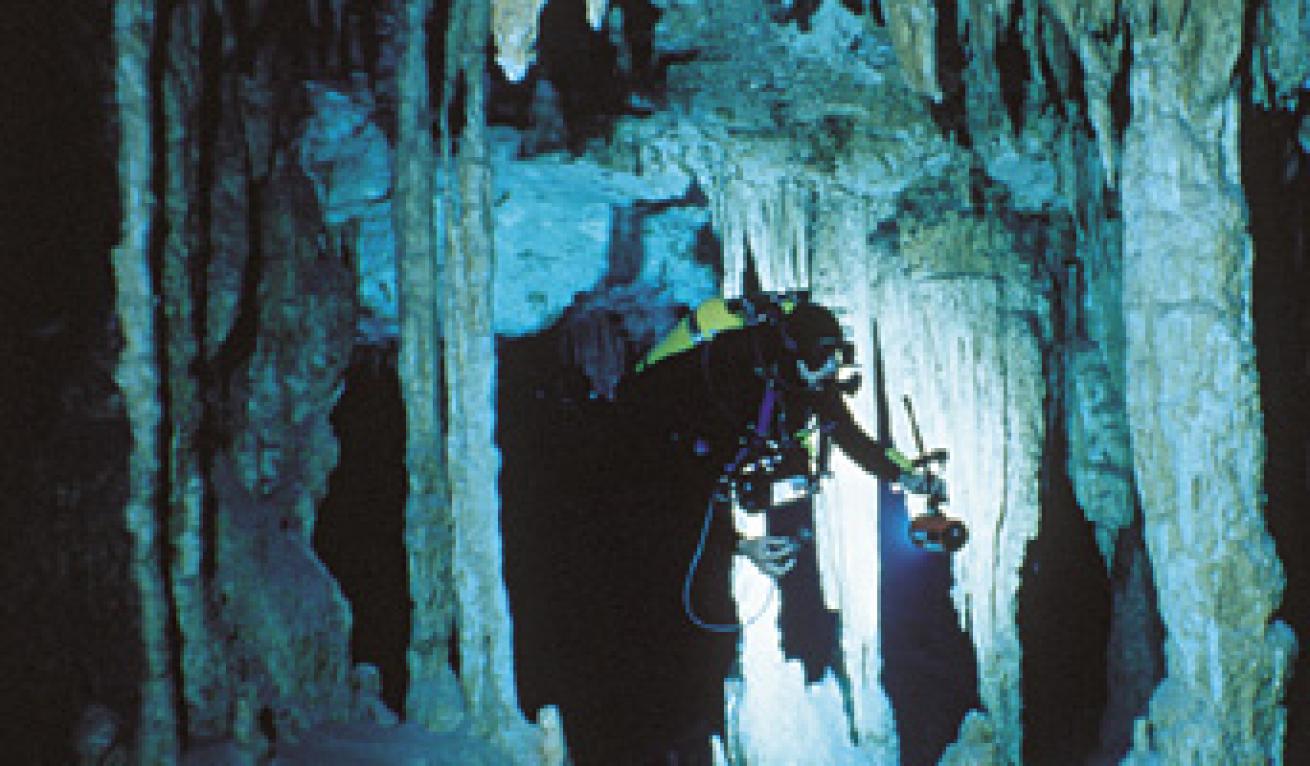
Pinpoint buoyancy control and modified fin kicks are two important safety skills for cave and cavern divers.
According to the old saying, "Curiosity killed the cat." The same holds true for open-water divers who swim into flooded caverns and caves beyond the limits of their gear and abilities.
In the words of the National Association of Cave Diving (NACD): "Cave diving is deceptively easy." Of course, NACD means it's a deceptively easy way for the untrained to die. The caverns and caves of central Florida alone have claimed well over 400 divers — yet thousands of tech divers safely visit these same passages every year. What's the difference between statistic and survivor? Proper training in cave diving techniques.
Silt Happens
The closed environment of flooded caves and caverns — the thing that makes them so interesting in the first place — also creates a world of unique hazards. Minimizing these hazards requires a different set of skills and techniques than those you learned in any open-water certification course.
Some hazards are obvious: low or zero light, the maze-like passageways that require penetration lines to follow, the inability to surface in case of emergencies. But one of the less obvious hazards of cave and cavern diving is silt. It's found in nearly every cave system. Whether composed of clay, decomposing vegetation or both, silt has the ability to eradicate visibility. One wrong fin kick or errant hand scull and the air-clear water becomes brown murk, and it can stay that way for days.
The solution to this hazard is spot-on buoyancy control and modified finning techniques that are at the heart of cavern and cave training.
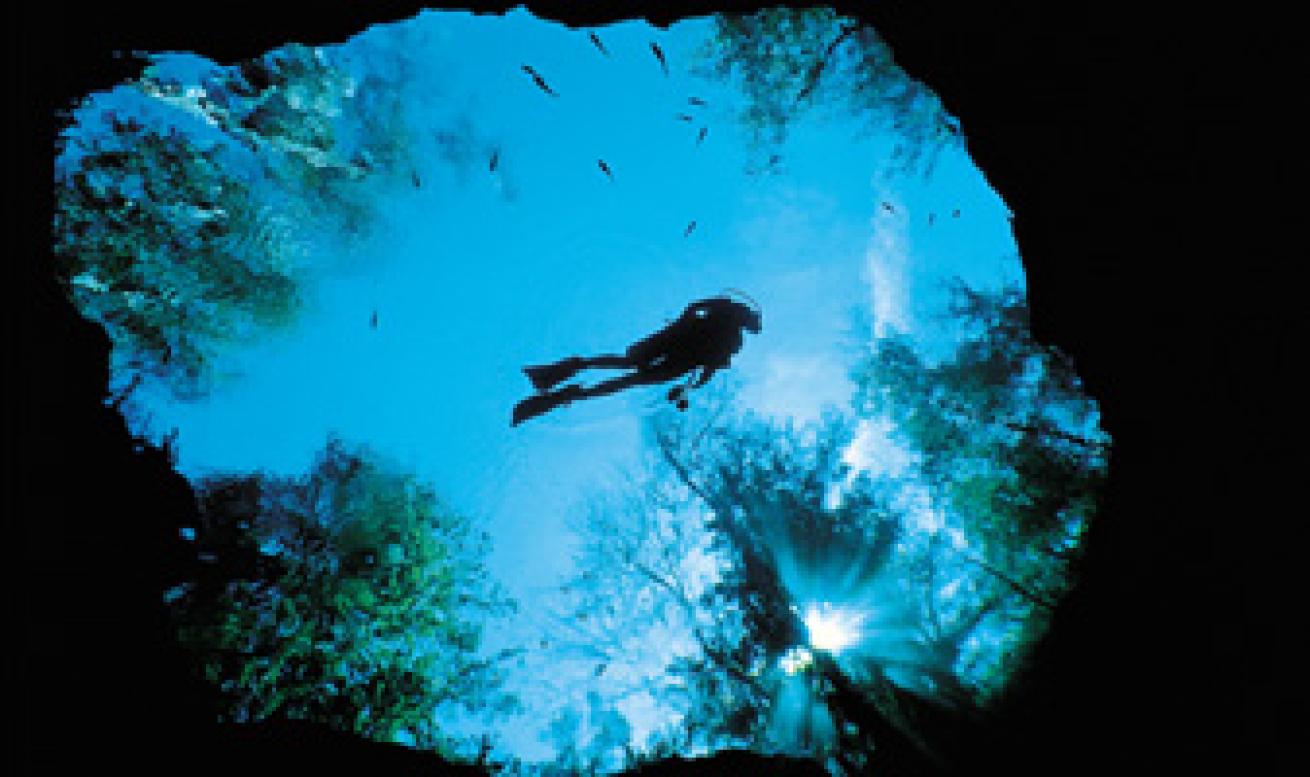
Photography by Masa Ushioda/Seapics.com
Mastering Buoyancy Control
Expert buoyancy control is largely a matter of weighting. Most recreational divers come to cavern classes overweighted. As a matter of practice, there has never been a reason for them to fine-tune their buoyancy, and most are surprised to find one of their first tasks is removing excess weight.
Overweighted divers have a tendency to swim through the water in a very inefficient position. The ballast weight pulls the diver's lower body down while the buoyancy in the BC pulls the shoulders up, giving the diver the hydrodynamics of a Peterbilt truck. This position also forces water from every kick of the fins directly into the silt on the bottom of the cavern.
In addition to losing some weight, divers typically have to relocate the weight on their gear to achieve proper trim in the water. Ideally, the cavern diver will swim through the water with a slightly head-down attitude. This places the fins slightly above the midline of the body and directs the thrust of the fins up and away from the sediments on the bottom of the cavern.
There are a number of methods for accomplishing this trim modification, including holders that position weights on the tank directly behind the shoulders. This brings the buoyancy of the BC in line with the ballast weight, helping to achieve neutral buoyancy without rotating the diver into an upright position.
Cave and cavern divers also trade aluminum tanks, which become positively buoyant at the end of the dive, for steel tanks, which maintain slightly negative buoyancy even when empty. The steel cylinder also provides a better distribution of negative buoyancy because of the weight-to-size ratio.
Another difference between open-water diving and cavern diving is that weights are positioned so that they cannot be dumped. In open water, dumping your weights assists you in reaching the surface. Inside a cave, the same act results in pinning you helplessly to the ceiling.
The whole process can be summed up as the rule of minimums: Use the minimum amount of weight required to achieve neutral buoyancy with the minimum amount of air in your BC.
Kick the Habit
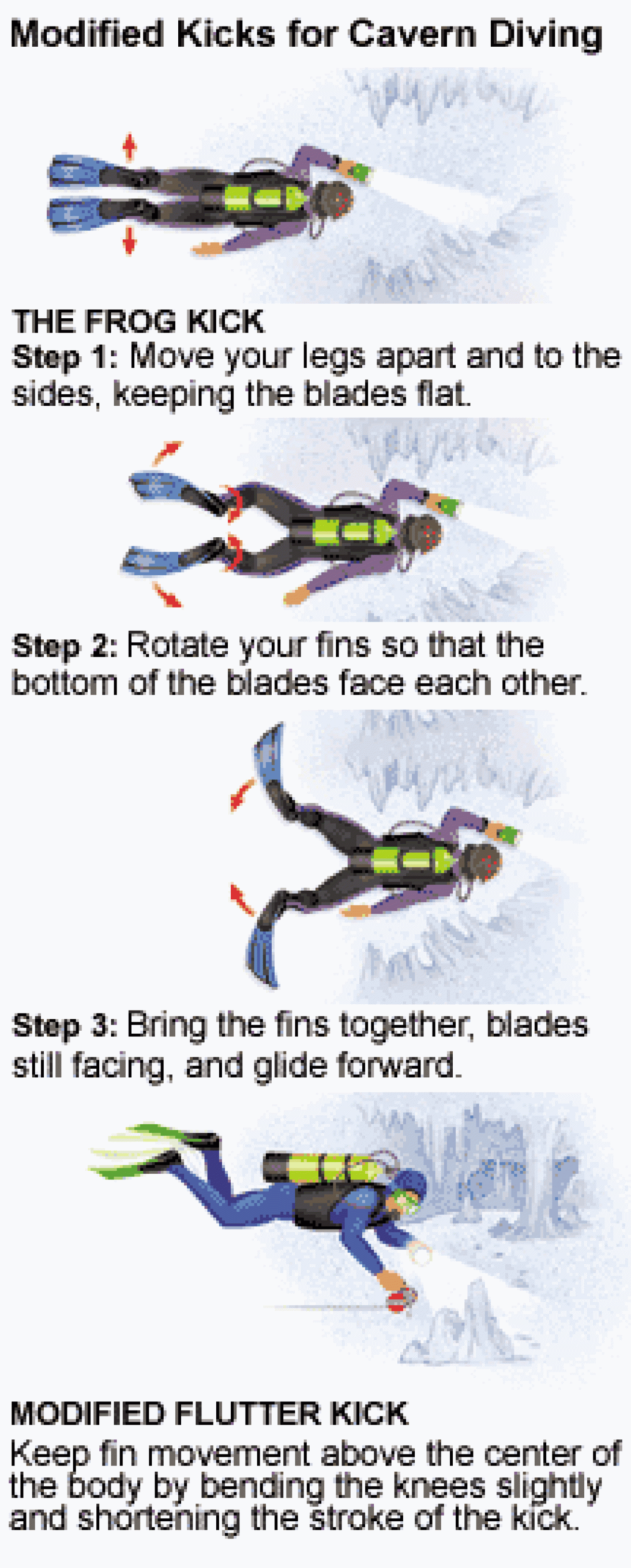
Modified fin kicks are another adaptation divers must make when entering a cave environment. Cave and cavern divers rarely use the full flutter kick because it produces too much turbulence directed toward the bottom. Cave and cavern certification courses typically cover two alternative kicks:
Frog Kick. The most common modified kick is the frog kick, which is accomplished by spreading the legs, rotating the fins so that the bottom of the fin blades come as close to facing each other as possible and then bringing the fins together, forcing water from between the two blades.
This kick isolates nearly all of the thrust and water turbulence to the area immediately behind the diver and requires a good deal less energy than a standard flutter kick.
In addition to increasing endurance and decreasing air consumption, the frog kick also provides another interesting benefit--you'll swim straighter. Most divers tend to drift slightly right or left as they flutter kick because one leg is slightly stronger than the other. Using the frog kick, the majority of all thrust comes from between the fins and directly behind the diver, which minimizes drift.
Modified Flutter Kick. This kick is accomplished by bending the knees slightly and shortening the stroke of the kick. When done properly, all fin movement takes place above the center of the body, minimizing water movement below the body.
After the cavern diver masters the new finning techniques, he'll learn how to utilize the fins to rotate his body with minimal disturbance of the water column. When mastered, this skill will allow the diver to utilize one fin to rotate his body on a point very close to the body's center.
The Payoff
When all the skills are combined, the well-trained cavern diver can swim, manage a light and a reel, keep track of his buddy without touching the cavern walls or disturbing its silt-laden bottom. Mastering these skills literally opens a new world to the recreational diver--a world of unique and beautiful geology unlike any other in diving.
Even if exploring caves and caverns isn't your idea of underwater fun, a cavern course conducted by a qualified instructor will equip you with useful skills for better open-water diving.
If you think back to your last few dive trips, you will probably remember seeing a cavern diver. He was the diver who stepped off the boat, descended slowly and efficiently to the bottom, never making contact, turned effortlessly into a proper swimming position and moved just as effortlessly through the entire dive. He never damaged the bottom with a touch or an erratic fin kick and his fins never disturbed a single grain of sand. These are the marks of the diver who has mastered buoyancy control, one of the essential skills in cavern exploration. If better buoyancy is your goal, a cavern course is a good place to learn it.
Spring, Cavern and Cave: What's the Difference?
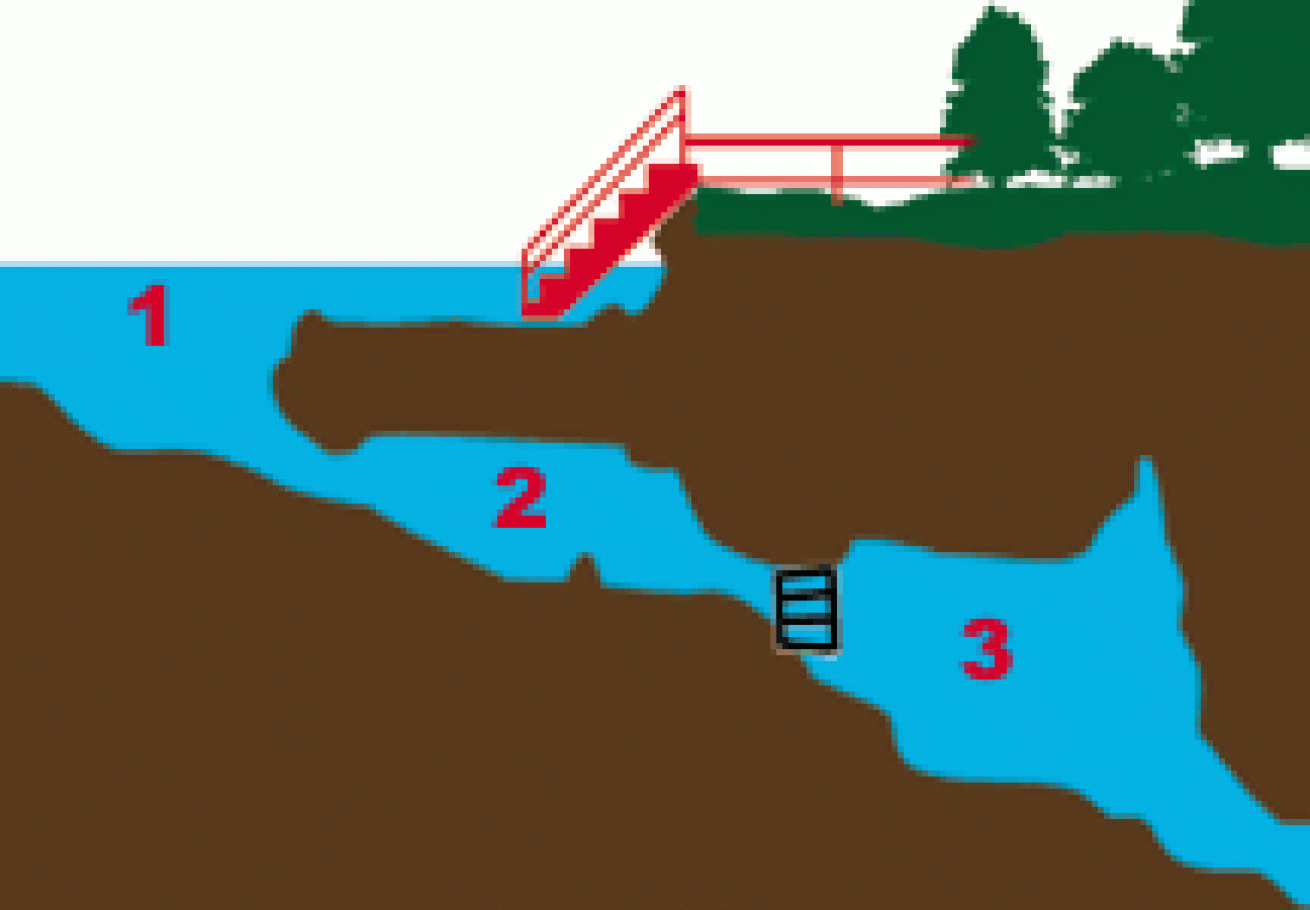
The popularity of freshwater spring diving has led to some confusion among divers about cave and cavern environments and the limitations that apply.
1) Spring Basins: Though connected to subterranean caves and caverns, these open-water pools require no special training or equipment. Access to the surface is not restricted, so divers can ascend directly to the surface in case of emergency. However, untrained divers must exercise caution and avoid entering caverns and caves. Stay in ambient light (both behind and in front of you). Often, the spring's owner or dive operator prohibits open-water divers from carrying dive lights.
2) Caverns: A cavern is simply the entryway to a cave where natural light penetrates and the entrance is always visible. However, the restricted environment may prevent divers from ascending directly to the surface and can present additional hazards including silt and confusing passageways. Caverns can be safely explored after a short training program and with a minimum amount of additional equipment. Some training agencies place certain depth or linear penetration restrictions on cavern divers.
3) Cave: At heavily dived sites, the entrance to the full cave environment is usually blocked by a locked grate or marked with "grim reaper" warning signs that make no bones about the deadly consequences of venturing inside. Cave certification and full cave diving gear are necessary to explore these restricted areas.
The Evolution of a Cave Diver
The path from open-water diver to full cave certification involves a progressive series of certifications that teach divers specialized techniques and introduce new gear.
STEP 1: CAVERN CERTIFICATION
A two-day cavern training course is the first step in the evolution from open-water diver to cave diver. Cavern students typically use their open-water equipment with the addition of two dive lights (a primary and a backup), a safety reel and an extended hose on one of the second stages. The course includes four cavern dives and about four hours of academics focusing on very basic line handling, buoyancy control and alternate finning techniques.
STEP 2: INTRO TO CAVE
This course is a true technical diving program, and intro students can expect a good dose of reality with their training. The training process is based on accident analyses and much of the academic program is about the mistakes cave divers make that lead to fatalities or injuries. For some divers this is quite a shift in thinking, and it accompanies some significant modifications in your gear. First, you'll need to swap your BC for a technical harness with back-mounted buoyancy wings. This is required to support the high-capacity single cylinder, two independent first-stage regulators, a primary dive light (at least 14 watts halogen or equivalent), two backup lights, a primary dive reel and a safety reel. You will refine the skills learned in cavern and learn procedures for finding a lost guideline, loss of light and gas sharing. This is a two-day course.
STEP 3: FULL CAVE CERTIFICATION
A Full Cave certification course starts with a slightly more complicated gear setup built around a set of twin high-capacity cylinders. Because decompression stops are a reality in long duration cave dives, a decompression cylinder is also required. In this course, the only new skill is complex line navigation where multiple lines are used to navigate more complicated systems. Emergency skills learned in previous courses are refined by practicing the skills over longer distances and with the increased levels of complexity expected on a full cave dive. A Full Cave course takes about four days to complete, including eight cave dives.

